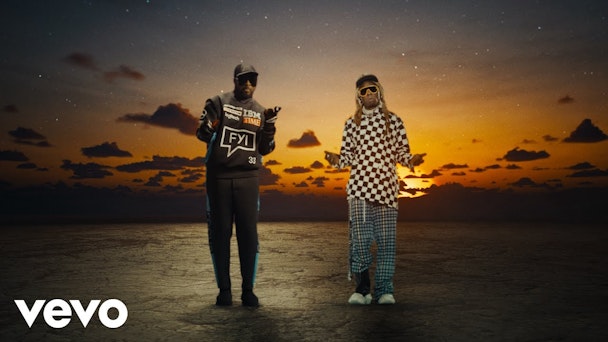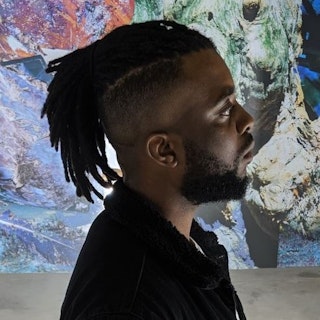The game beyond the game: live sports has more entry points than ever for brands
Joel Goodhall, senior strategist at Uncommon, reveals the many new ways brands can engage in and around live sports. Prepare to be surprised.

Will.I.Am and Lil Wayne with Formula
‘The treasured die-hards are now joined by a host of different types of fans enjoying the game in new ways.’ - UK broadcaster Sky Sports.
Sports fans are some of the most passionate communities in the world; today, they connect with sports in new ways. Nielsen reported that 40% of fans prefer content unrelated to a live sports event. The growing desire for experiences beyond the game is fuelled by a more diverse mix of fans redefining the boundaries of sport. The ball is in the courts of the teams and sports to take advantage of these new opportunities.
First, let’s explore why we should care.
Subcultures are powering the mainstream
‘The average fan and how they express their love for sports has evolved, and it’s time the sporting world evolves with them.’ - Kenny Annan-Jonathan, the world’s first creative director of a Premier League team, Crystal Palace FC.
New conversations are emerging in and around sports from surrounding subcultures. Which NBA athlete had the freshest outfit when going through the tunnel? Is it better to have Haaland or Salah as the captain of your fantasy team? Did you see Rashford at the Louis Vuitton show? Have you seen @BFordLancers attempt to become a Roblox football legend? These conversations are new, exciting, and daunting, as they can happen without watching live games and interacting with a sports team’s direct channels.
The good news is that sports and sports teams have shown it’s possible to play a role in these subcultures. PSG and Jordan’s partnership in 2018 brought fashion on to the pitch (and jerseys to the catwalk). Football teams and the NBA have built leagues dedicated to esports - a billion-dollar industry. Man City FC has partnered with Puma to create a dedicated esports clothing collection. F1 and Will.I.Am have collaborated to drop new music across the race season to unite the two communities. Roblox and Fortnite are now virtual homes for the NFL to reach their youngest fans. And, the fantasy game for the Premier League has its web series (FPL Show) with commentators and an army of disappointed players each weekend - damn you, Pep Guardiola.
The combination of subcultures and sports brings energy and optimism to an industry struggling with a core product declining in viewership - the live event.
Subcultures are the new entry points for sports brands.
We can look at what’s happening in sports through the lens of the academic work on traditional product marketing by the likes of the Ehrenberg-Bass Institute. Category Entry Points (CEPs) are a key component - the more consumption scenarios a consumer associates with your brand/product, the greater your mental availability and sales. In sports, subcultures can create new entry points for people - allowing brands to grow mental availability and fanbase.
In 2021, Sky Sports’ research revealed that many football fans are now more dedicated to the game itself rather than to a particular team. This comes as no surprise when you consider how the superstar footballers with social followings have become the face of the game v the clubs. Another example is the research highlighting that social and the Netflix doc ‘Drive to Survive’ have made young F1 driver Lando Norris more popular than Hamilton with younger fans. In the traditional sense, you’d think fans would support the more successful driver (Hamilton seven championships, Norris 0); however, it’s about who wins the attention of fans in the right spaces.
We need to get creative with technology like it’s 2020
“Probably 99.5% of our fans are never going to have the opportunity to go into an NBA arena, and I think the notion that you can become part of that experience is phenomenal.” Adam Silver, NBA commissioner
In 2020, sports and sports teams had to channel Adam Silver’s desire to go beyond the stadium out of necessity. Games were paused. Stadiums were empty. All of a sudden, the Premier League was streaming Fifa tournaments between players, virtual fans were front row in the NBA playoffs, the BTS of a club became their social content, broadcasters created co-watching moments, virtual worlds emerged, and teams flocked to new platforms like Discord to stay in touch. The pandemic sucked for many reasons, but it also unlocked experimentation and learnings that can accelerate how sports evolve their offerings and play in subcultures.
The three steps playbooks to creating new entry points
It’s easy to feel overwhelmed or compelled to pick a new lane and throw all your eggs in one basket. Especially when you consider all the behaviors it feels you need to cater towards (shout out to Sports Innovation Lab’s fluid fan research).
Advertisement
However, we believe that entering a subculture begins with creating bridges with credible partners in that space (endorsing) so you can test and learn (experimenting) before fully committing and investing in new platforms and communities (expanding). In short, sports and sports teams don’t need to commit to a new space at the beginning fully. The more challenging requirement is a deeper cross-functional effort to attract and engage fans. Marketing, talent, partnerships, PR and digital teams play a role.
Let’s get into how this works with some real-world examples:
Stage 1: Endorse. Support the fan subcultures.
The first step to entering these new spaces is to support the existing behaviors and voices in this space. E-sports athlete sponsorships are a relevant example today, as sports teams are backing gamers with infrastructure to play at the highest level. This is more of a partnership play that helps to create bridges into gaming communities – ultimately extending the club’s reach via these ambassadors.
Another example comes from the merging world of fashion and sport. In tennis, sport rights holders collaborated with Gucci to allow Jannick Sinner to rock a luxury duffle bag on Wimbledon Court. Wimbledon, normally criticized for its ‘all-white’ policies, became celebrated for this crossover with luxury fashion.
Endorsing by loosening the rules is also something we see in football jersey launches, with many launches focusing on the jersey styled with a casual outfit - Chelsea jersey + jeans - rather than trying to push a full kit on to audiences. These efforts to blend sport and fashion allow sports and sports teams to be seen and engaged in new ways.
Stage 2: Experiment. Trial new forms of new sports consumption with the subcultures
The next stage focuses on playing with new types of experiences and content. In this stage, internal teams work together to evolve the sports/sports teams offering.
For example, FaZe Clan worked with Man City to create content that serves the growing gamer / YouTuber audience better. This created a different dynamic between the Man City athletes and their fans.
On top of sponsoring esports athletes, these efforts paved the way for Man City to build out its gaming offerings credibly. In the fashion world, Arsenal and Adidas have been applauded by rivals for their merchandise offering as they’ve made them resonate with various London communities. From a pre-match kit inspired by Transport For London to one inspired by Notting Hill Carnival and a special kit that stands against knife crime and youth violence, Arsenal x Adidas found ways to connect with fashionable Londoners. Efforts in the experimental phase can be seen as year-long initiatives that provide learnings for sports and sports teams to build out bigger and better offerings.
Stage 3: Expand. Build new platforms and communities as an extension of that brand.
The ultimate stage in this playbook is where sports and sports teams create new platforms to serve and build communities directly. Man City’s efforts have led to successful social followings and merchandise tailored to the gaming community. The NFL now has a zone in Fortnite sponsored by Visa, which allows them to serve younger fans with virtual merch, games and experiences that keep them engaged all season. At this stage, sports and sports teams can fully integrate new communities into their offering, behaving more like an entertainment brand with multiple avenues.
Embrace the subcultures
“If we can seize the opportunity, we will capture a much bigger piece of the market, which will also present new business opportunities that didn’t exist before.” - Dídac Lee, head of FC Barcelona Digital.
The subcultures referenced will evolve with and without sports and sports teams, giving these brands new opportunities. So, it’s time for marketers to get their heads out of the sand and experiment with new behaviors. However, you don’t have to become the face of music x sport, fashion x sport, gaming x sport overnight. One step at a time!

